2018 Massive Ground Display FB
[vc_row padding_top=”0px” padding_bottom=”0px”][vc_column fade_animation_offset=”45px” width=”1/1″][text_output]
HOUSTON Ground Display Aircraft Sneak Peek!
Last Update: 10/17/18 13:48 CT
In addition to the amazing Blue Angels, you will see some of the best civilian and military pilots in the world – flying for you. This sneak peek represents less than half of the total number of aircraft that will be on display!
An Important Note on the Warbird Display Ramp
Some aircraft below are on the WARBIRD DISPLAY RAMP. Display times will vary. If you’d like to see these aircraft … please arrive early! Below is your Insider peek into several notable aircraft you will be able to see this weekend, both on the ground and flying.
Please note: Aircraft below might not be the exact paint scheme, tail flash, or unit shown. All display aircraft are subject to change without notice. Some aircraft arrivals are still pending because of Hurricane Michael.
AC-130 Spectre Gunship!!!
“The AC-130 gunship is a devastating display of force and firepower. Through the years, the aircraft has been equipped with an array of side-fired canons, howitzers, mini-guns, wing mounted missiles and bombs and laser guided missiles launched from the rear cargo door, earning it the moniker the “Angel of Death.”
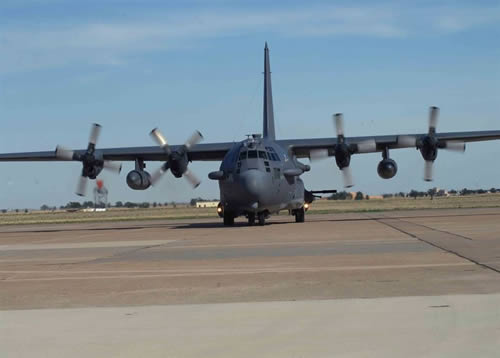
The primary missions of the gunship are close air support, air interdiction and armed reconnaissance. The heavily armed aircraft is outfitted with sophisticated sensor, navigation and fire control systems, allowing it to track and target multiple targets using multiple munitions with surgical precision. Another strength of the gunship is the ability to loiter in the air for extended periods of time, providing aerial protection at night and during adverse weather. The AC-130 relies heavily on visual targeting at low altitudes and punishes enemy targets while performing pylon turns around a fixed point on the ground during attack. The Air Force is the only operator of the AC-130 and the gunship has been providing close air support for special operators for the last 50 years.
Over the past four decades, AC-130s have deployed constantly to hotspots throughout the world in support of special operations and conventional forces. In South America, Africa, Europe and throughout the Middle East, gunships have significantly contributed to mission success.
As of Sept. 19, 2017, the AC-130J Ghostrider, the Air Force’s next-generation gunship achieved Initial Operating Capability and will be tested and prepared for combat deployment in the next few years. The AC-130J is the fourth generation gunship replacing the aging fleet of AC-130U/W gunships.
The Ghostrider is outfitted with a Precision Strike Package, which includes 30mm and 105 mm cannons and precision guided munitions of GBU-39 Small Diameter Bombs and AGM-176 Griffin missiles. The 105mm M102 howitzer system is a devastating weapon that can fire off 10 50lbs shells per minute with precision accuracy.
There are 10 Ghostrider gunships in the current fleet and the Air Force plans on purchasing 27 more by fiscal year 2021.”
B-52 Stratofortress . . . “BUFF!”
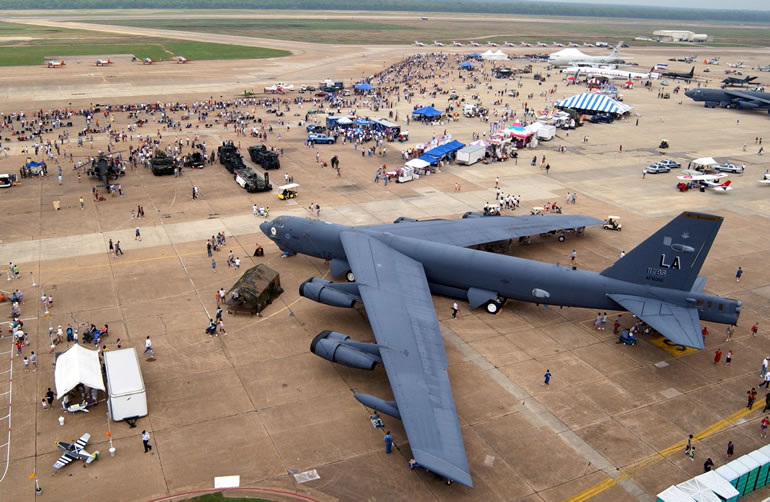
“The B-52 is a long-range, heavy bomber that can perform a variety of missions. The bomber is capable of flying at high subsonic speeds at altitudes up to 50,000 feet (15,166.6 meters). It can carry nuclear or precision guided conventional ordnance with worldwide precision navigation capability.”
Source/Link:
http://www.af.mil/AboutUs/FactSheets/Display/
tabid/224/Article/104465/b-52-stratofortress.aspx
S-3 Viking
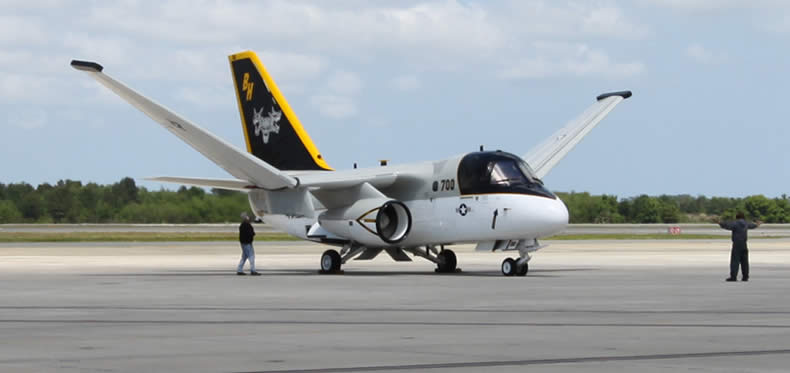
The Lockheed S-3 Viking is a four-seat, twin-engine turbofan-powered jet aircraft that was used by the U.S. Navy primarily for anti-submarine warfare. In the late 1990s, the S-3B’s mission focus shifted to surface warfare and aerial refueling. The Viking also provided electronic warfare and surface surveillance capabilities to the carrier battle group. A carrier-based, subsonic, all-weather, multi-mission aircraft with long range; it carried automated weapon systems, and was capable of extended missions with in-flight refueling. Because of the Viking’s engines’ characteristic sound, it was nicknamed the “Hoover” after the vacuum cleaner brand.
The S-3 was retired from front-line US Navy fleet service aboard aircraft carriers in January 2009, with its missions being assumed by other platforms such as the P-3C Orion, Sikorsky SH-60 Seahawk, and Boeing F/A-18E/F Super Hornet. Several aircraft were flown by Air Test and Evaluation Squadron Thirty (VX-30) at Naval Base Ventura County / NAS Point Mugu, California, for range clearance and surveillance operations[2] on the NAVAIR Point Mugu Range until 2016, and one S-3 is operated by the National Aeronautics and Space Administration (NASA) at the NASA Glenn Research Center.
Info Source: https://en.wikipedia.org/wiki/Lockheed_S-3_Viking
C-17 Globemaster III
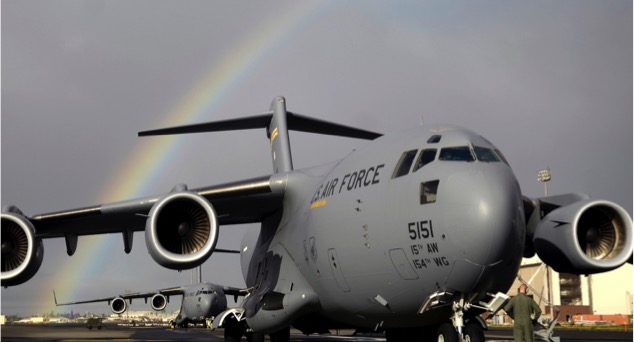
“The C-17 Globemaster III is the newest, most flexible cargo aircraft to enter the airlift force. The C-17 is capable of rapid strategic delivery of troops and all types of cargo to main operating bases or directly to forward bases in the deployment area. The aircraft can perform tactical airlift and airdrop missions and can transport litters and ambulatory patients during aeromedical evacuations when required. The inherent flexibility and performance of the C-17 force improve the ability of the total airlift system to fulfill the worldwide air mobility requirements of the United States.”
Source/Link: http://www.af.mil/AboutUs/FactSheets/
Display/tabid/224/Article/104523/c-17-globemaster-iii.aspx
F-16C Fighting Falcon
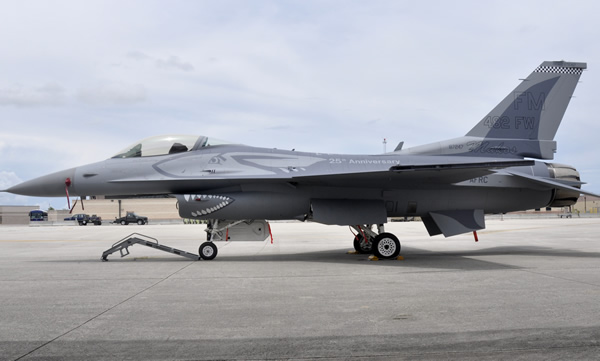
“The F-16 Fighting Falcon is a compact, multi-role fighter aircraft. It is highly maneuverable and has proven itself in air-to-air combat and air-to-surface attack. It provides a relatively low-cost, high-performance weapon system for the United States and allied nations. In an air combat role, the F-16’s maneuverability and combat radius (distance it can fly to enter air combat, stay, fight and return) exceed that of all potential threat fighter aircraft. It can locate targets in all weather conditions and detect low flying aircraft in radar ground clutter. In an air-to-surface role, the F-16 can fly more than 500 miles (860 kilometers), deliver its weapons with superior accuracy, defend itself against enemy aircraft, and return to its starting point. An all-weather capability allows it to accurately deliver ordnance during non-visual bombing conditions.”
Credit/Source:
http://www.af.mil/AboutUs/FactSheets/Display/
tabid/224/Article/104505/f-16-fighting-falcon.aspx
MQ-9 Reaper
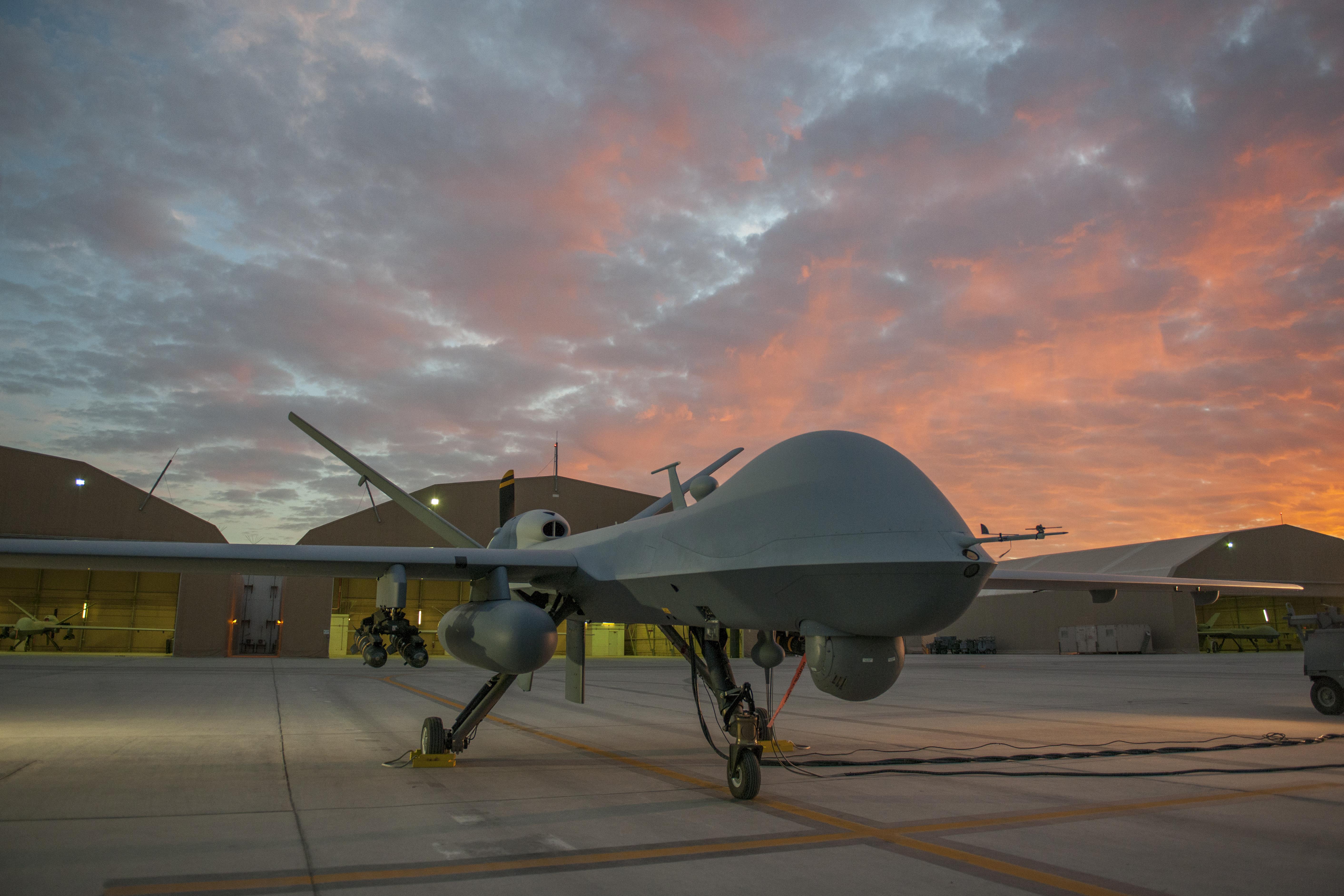
The General Atomics MQ-1 Predator is an American remotely piloted aerial vehicle (RPA) built by General Atomics and used primarily by the United States Air Force (USAF) and Central Intelligence Agency (CIA). Initially conceived in the early 1990s for aerial reconnaissance and forward observation roles, the Predator carries cameras and other sensors but has been modified and upgraded to carry and fire two AGM-114 Hellfire missiles or other munitions. The aircraft, in use since 1995, has seen combat in war in Afghanistan, Pakistan, the NATO intervention in Bosnia, Serbia, Iraq War, Yemen, Libyan civil war, the intervention in Syria, and Somalia.
The USAF describes the Predator as a “Tier II” MALE UAS (medium-altitude, long-endurance unmanned aircraft system). The UAS consists of four aircraft or “air vehicles” with sensors, a ground control station (GCS), and a primary satellite link communication suite.Powered by a Rotax engine and driven by a propeller, the air vehicle can fly up to 400 nmi (460 mi; 740 km) to a target, loiter overhead for 14 hours, then return to its base.
Credit/Source:
https://en.wikipedia.org/wiki/General_Atomics_MQ-1_Predator
AH-64 Apache
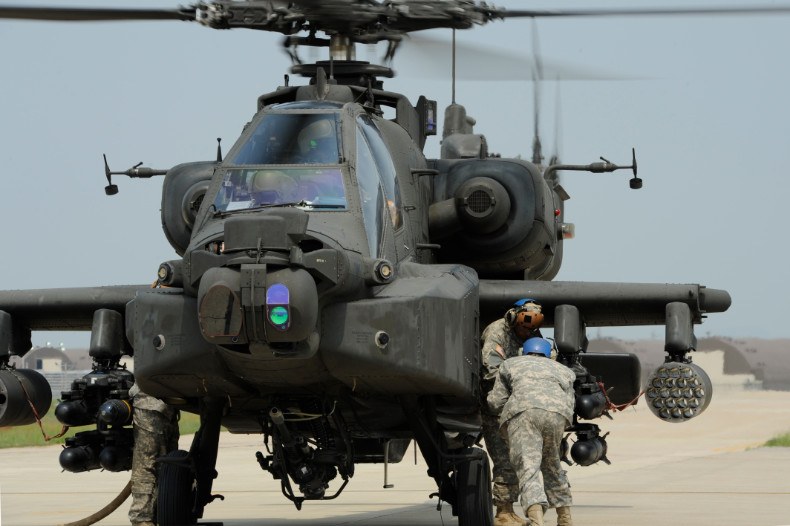
The Boeing AH-64 Apache is an American four-blade, twin-turboshaft attack helicopter with a tailwheel-type landing gear arrangement and a tandem cockpit for a two-man crew. It features a nose-mounted sensor suite for target acquisition and night vision systems. It is armed with a 30 mm (1.18 in) M230 chain gun carried between the main landing gear, under the aircraft’s forward fuselage. It has four hardpoints mounted on stub-wing pylons, typically carrying a mixture of AGM-114 Hellfire missiles and Hydra 70 rocket pods. The AH-64 has a large amount of systems redundancy to improve combat survivability.
The U.S. Army is the primary operator of the AH-64; it has also become the primary attack helicopter of multiple nations, including Greece, Japan, Israel, the Netherlands, Singapore, and the United Arab Emirates; as well as being produced under license in the United Kingdom as the AgustaWestland Apache. American AH-64s have served in conflicts in Panama, the Persian Gulf, Kosovo, Afghanistan, and Iraq. Israel used the Apache in its military conflicts in Lebanon and the Gaza Strip; British and Dutch Apaches have seen deployments in wars in Afghanistan and Iraq.
Credit/Source:
https://en.wikipedia.org/wiki/Boeing_AH-64_Apache
MH-60 Jayhawk
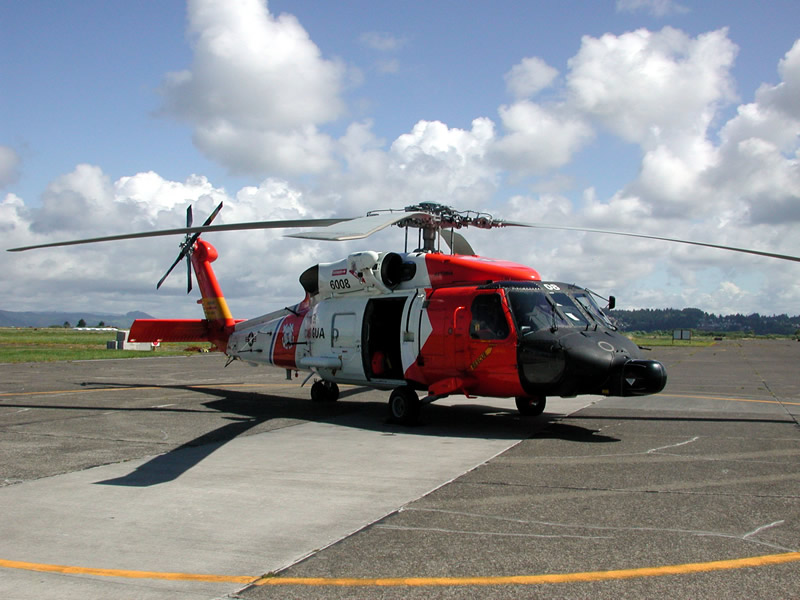
“The Sikorsky MH-60T Jayhawk is a multi-mission, twin-engine, medium-range helicopter operated by the United States Coast Guard for search and rescue, law enforcement, military readiness and marine environmental protection missions.
Originally designated HH-60J before being upgraded and redesignated beginning in 2007, the MH-60T is designed to fly a crew of four up to 300 mi (483 km) offshore, hoist up to 6 additional people on board while remaining on-scene for up to 45 minutes and return to base while maintaining an adequate fuel reserve. Normal cruising speed of the MH-60T is 135 to 140 kn (155 to 161 mph) and the aircraft is capable of reaching 180 kn (207 mph) for short durations. The MH-60T can fly at 140 kn (161 mph) for six to seven hours.
Chosen to replace the HH-3F Pelican, the MH-60T is a member of the Sikorsky S-70 family of helicopters and is based on the United States Navy’s SH-60 Seahawk helicopter. Development began in September 1986, first flight was achieved on 8 August 1989, and the first HH-60J entered USCG service in June 1990. Production ended in 1996 after 42 helicopters were produced; three retired SH-60F Seahawks were also remanufactured to MH-60T specifications beginning in 2010. A total of 42 MH-60Ts are in service with the Coast Guard.
MH-60 Jayhawk Credit/Source:
https://en.wikipedia.org/wiki/Sikorsky_MH-60_Jayhawk
HC-144 Ocean Sentry
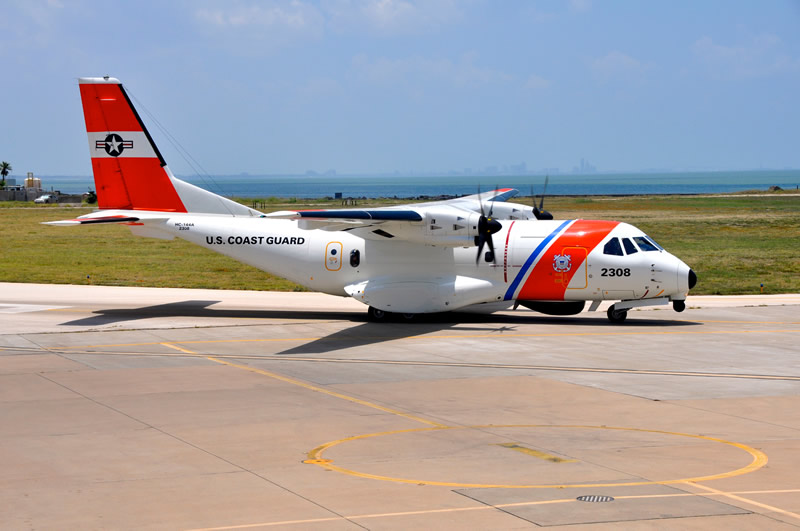
“The EADS HC-144 Ocean Sentry is a medium-range, twin-engined aircraft used by the United States Coast Guard in the search-and-rescue and maritime patrol missions. Based on the Airbus Military CN-235 it was procured as a “Medium Range Surveillance Aircraft.” The HC-144 is supplied by Airbus Group, Inc formerly EADS North America and is built in Spain by Airbus Military.
Intended to replace the Dassault HU-25 Guardian jet, the HC-144A Ocean Sentry is part of the Coast Guard’s Integrated Deepwater System Program of recapitalization and new-asset acquisition. Based on the CN-235-300 MP Persuader, the maritime patrol version of the CN-235 military transport, the HC-144 offers a longer endurance than the HU-25 it is replacing in U.S. Coast Guard service, as well as better performance in the low-level observation role.
The HC-144A has an eight-hour endurance, which makes it suited for the command and control and search and rescue roles. Its rear ramp provides for transport of standard cargo pallets. It also features short takeoff and landing capability.”
HU-144A Copy Credit/Source:
https://en.wikipedia.org/wiki/EADS_HC-144_Ocean_Sentry
NASA T-38 Talon
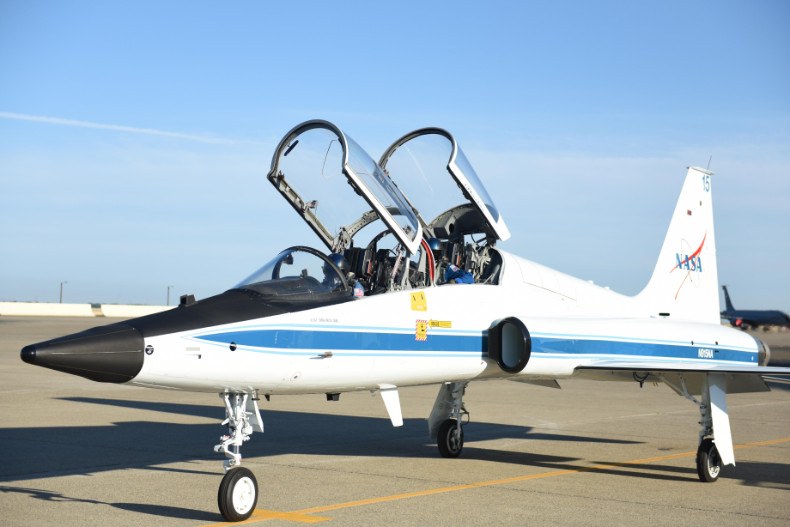
“The T-38 Talon is a twin-engine, high-altitude, supersonic jet trainer used in a variety of roles because of its design, economy of operations, ease of maintenance, high performance and exceptional safety record. Air Education and Training Command is the primary user of the T-38 for joint specialized undergraduate pilot training. Air Combat Command, Air Force Materiel Command and the National Aeronautics and Space Administration also use the T-38A in various roles.”
Copy Credit/Source:
http://www.af.mil/AboutUs/FactSheets/
Display/tabid/224/Article/104569/t-38-talon.aspx
NASA WB-57
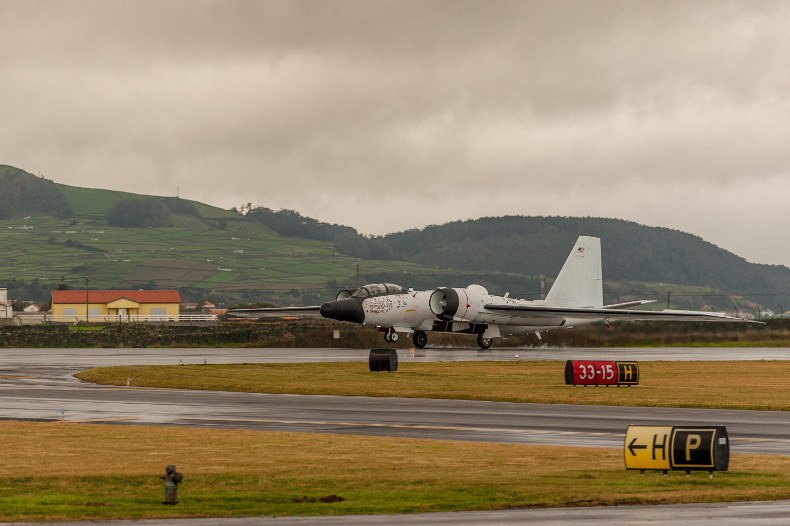
“The Martin B-57 Canberra is an American-built, twinjet tactical bomber and reconnaissance aircraft that entered service with the United States Air Force (USAF) in 1953. The B-57 is a license-built version of the British English Electric Canberra manufactured by the Glenn L. Martin Company. Initial Martin-build models were highly similar to their British-built counterparts; Martin later modified the design to incorporate larger quantities of US-sourced components and produced the aircraft in several different variants.”
Credit/Source:
https://en.wikipedia.org/wiki/Martin_B-57_Canberra
EA-18G Growler
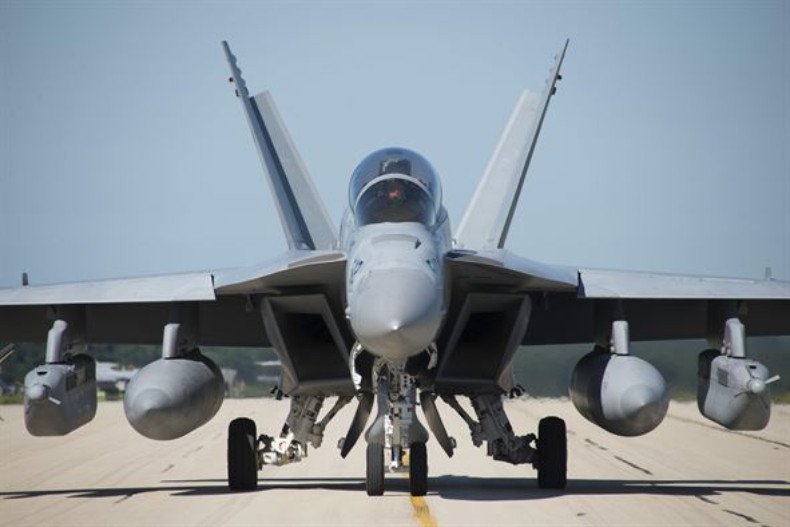
The Boeing EA-18G Growler is an American carrier-based electronic warfare aircraft, a specialized version of the two-seat F/A-18F Super Hornet. The EA-18G replaced the Northrop Grumman EA-6B Prowlers in service with the United States Navy. The Growler’s electronic warfare capability is primarily provided by Northrop Grumman. The EA-18G began production in 2007 and entered operational service in late 2009.
Credit/Source:
https://en.wikipedia.org/wiki/Boeing_EA-18G_Growler
HU-16 Albatross
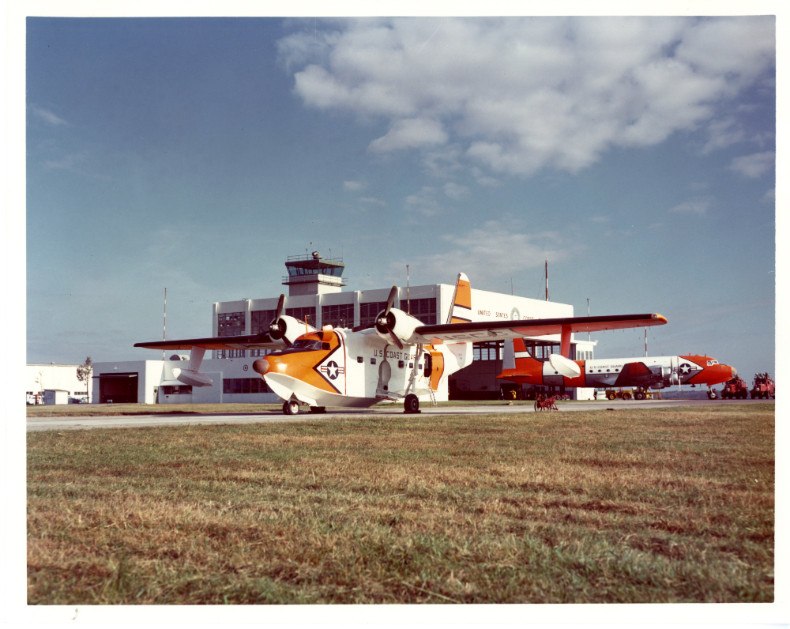
The Grumman HU-16 Albatross is a large twin–radial engine amphibious flying boat that was used by the United States Air Force (USAF), the U.S. Navy (USN) and the U.S. Coast Guard (USCG), primarily as a search and rescue aircraft. Originally designated as the SA-16 for the USAF and the JR2F-1 and UF-1 for the USN and USCG, it was redesignated as the HU-16 in 1962.
Source/Credit:
https://en.wikipedia.org/wiki/Grumman_HU-16_Albatross
BT-13 Valiant
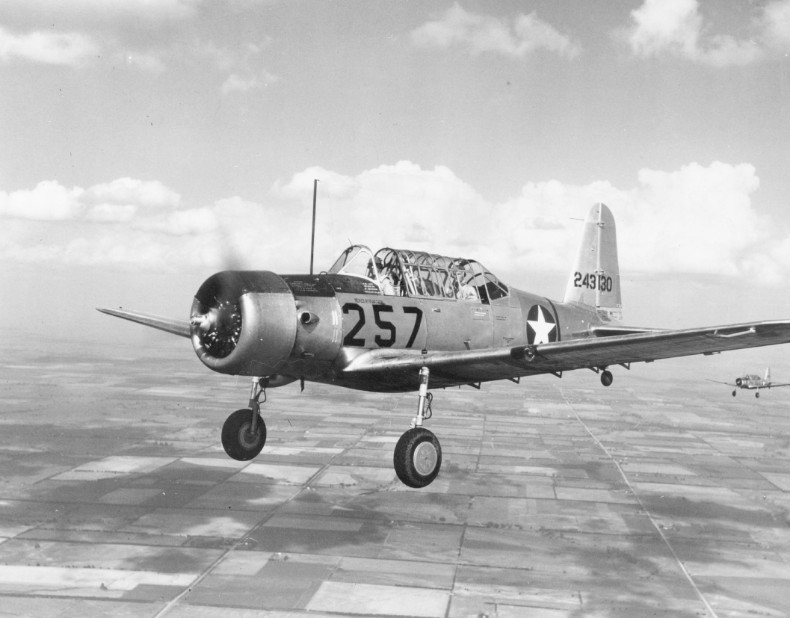
The Vultee BT-13 Valiant was an American World War II-era basic trainer aircraft built by Vultee Aircraft for the United States Army Air Corps, and later US Army Air Forces. A subsequent variant of the BT-13 in USAAC/USAAF service was known as the BT-15 Valiant, while an identical version for the US Navy was known as the SNV and was used to train naval aviators for the US Navy and its sister services, the US Marine Corps and US Coast Guard.
Source/Credit:
https://en.wikipedia.org/wiki/Vultee_BT-13_Valiant
Naval Aircraft Factory N3N
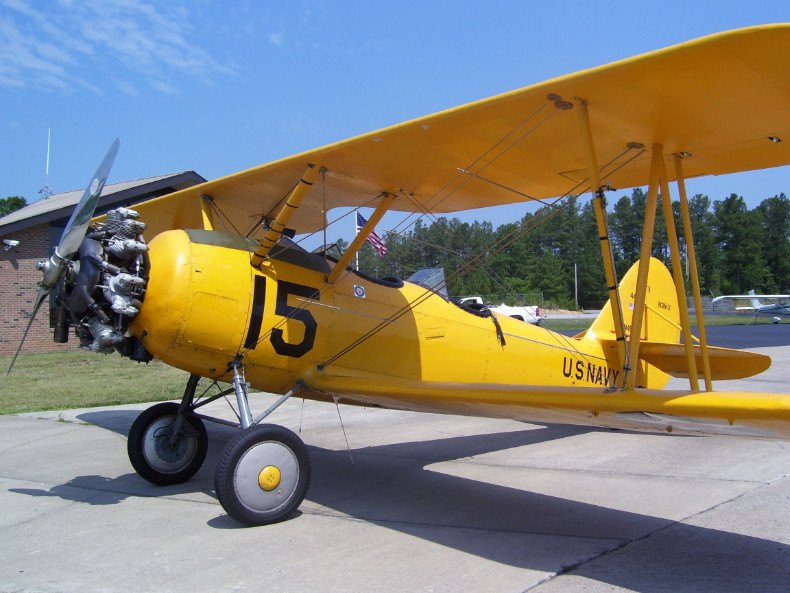
The Naval Aircraft Factory N3N was an American tandem-seat, open cockpit, primary training biplane aircraft built by the Naval Aircraft Factory (NAF) in Philadelphia, Pennsylvania, during the 1930s.
Source/Credit:
https://en.wikipedia.org/wiki/Naval_Aircraft_Factory_N3N
Fairchild PT-19
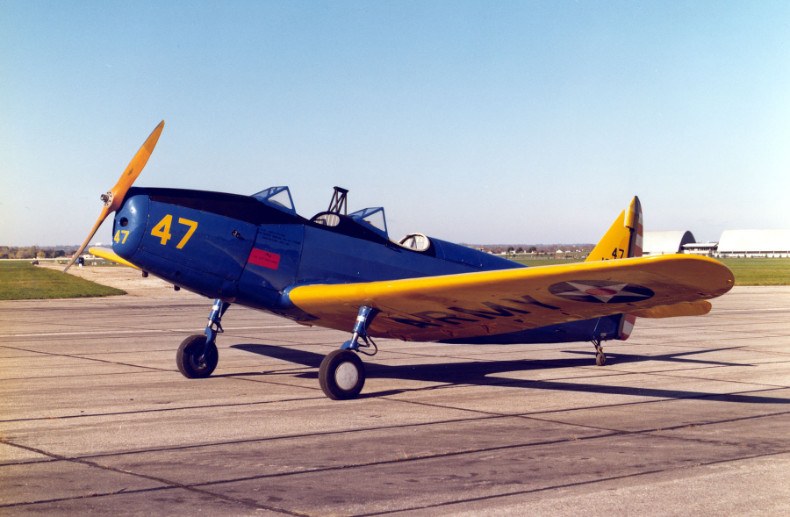
“The Fairchild PT-19 (company designation Fairchild M62) is an American Fairchild Aircraft monoplane primary trainer aircraft that served with the United States Army Air Forces, RAF and RCAF during World War II. It was a contemporary of the Kaydet biplane trainer and was used by the USAAF during Primary Flying Training as the introductory pre-solo phase trainer for introducing new pilots to flying before passing them on to the more agile Kaydet. As with other USAAF trainers of the period, the PT-19 had multiple designations based on the powerplant installed.”
Source/Credit:
https://en.wikipedia.org/wiki/Fairchild_PT-19
T-6 Texan
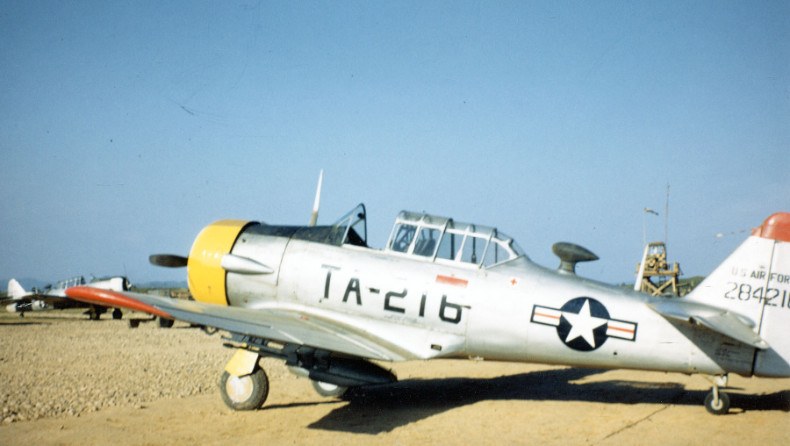
“The North American Aviation T-6 Texan is a single-engined advanced trainer aircraft used to train pilots of the United States Army Air Forces (USAAF), United States Navy, Royal Air Force, and other air forces of the British Commonwealth during World War II and into the 1970s. Designed by North American Aviation, the T-6 is known by a variety of designations depending on the model and operating air force. The United States Army Air Corps (USAAC) and USAAF designated it as the AT-6, the United States Navy the SNJ, and British Commonwealth air forces, the Harvard, the name by which it is best known outside of the US. After 1962, US forces designated it the T-6. It remains a popular warbird aircraft used for airshow demonstrations and static displays. It has also been used many times to simulate various Japanese aircraft, including the Mitsubishi A6M Zero in movies depicting World War II in the Pacific.”
Source/Credit:
https://en.wikipedia.org/wiki/North_American_T-6_Texan
C-45 Expeditor
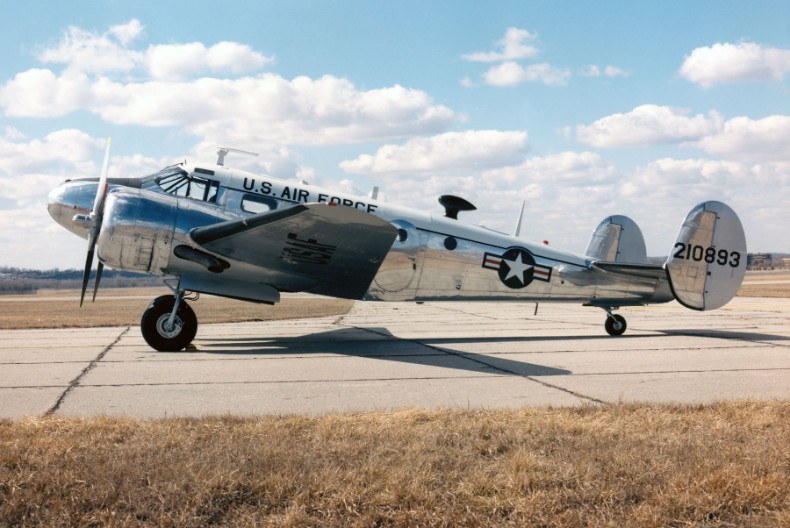
“The Beechcraft Model 18 (or “Twin Beech”, as it is also known) is a six to 11-seat, twin-engined, low-wing, tailwheel light aircraft manufactured by the Beech Aircraft Corporation of Wichita, Kansas. Continuously produced from 1937 to November 1969 (over 32 years, the world record at the time), over 9,000 were produced, making it one of the world’s most widely used light aircraft. Sold worldwide as a civilian executive, utility, cargo aircraft, and passenger airliner on tailwheels, nosewheels, skis or floats, it was also used as a military aircraft.
During and after World War II, over 4,500 Beech 18s saw military service—as light transport, light bomber (for China), aircrew trainer (for bombing, navigation and gunnery), photo-reconnaisance, and “mother ship” for target drones—including United States Army Air Forces (USAAF) C-45 Expeditor, AT-7 Navigator, AT-11 Kansan; and United States Navy (USN) UC-45J Navigator, SNB-1 Kansan, and others. In World War II, over 90% of USAAF bombardiers and navigators trained in these aircraft.
In the early postwar era, the Beech 18 was the pre-eminent “business aircraft” and “feeder airliner.” Besides carrying passengers, its civilian uses have included aerial spraying, sterile insect release, fish seeding, dry ice cloud seeding, aerial firefighting, air mail delivery, ambulance service, numerous movie productions, skydiving, freight, weapon- and drug-smuggling, engine testbed, skywriting, banner towing, and stunt aircraft. Many are now privately owned, around the world, with over 300 in the U.S. still on the FAA Aircraft Registry in December 2014″
Credit/Source:
https://en.wikipedia.org/wiki/Beechcraft_Model_18
B-17G Flying Fortress
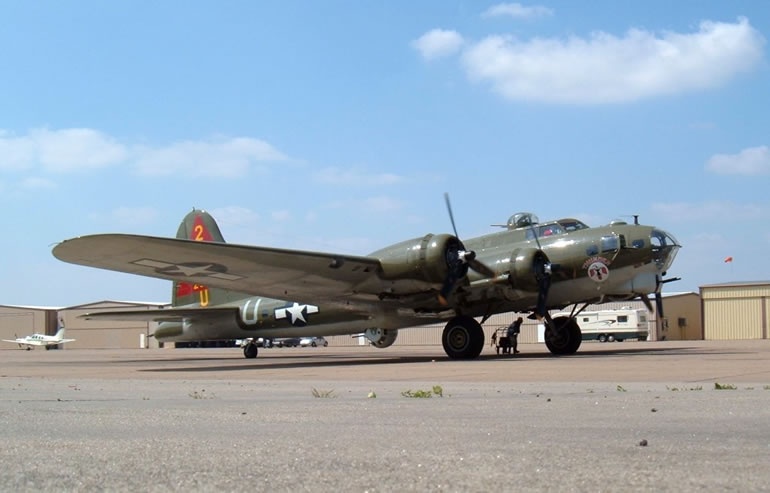
“The Boeing B-17 Flying Fortress is a four-engine heavy bomber developed in the 1930s for the United States Army Air Corps (USAAC). Competing against Douglas and Martin for a contract to build 200 bombers, the Boeing entry outperformed both competitors and exceeded the air corps’ performance specifications. Although Boeing lost the contract because the prototype crashed, the air corps ordered 13 more B-17s for further evaluation. From its introduction in 1938, the B-17 Flying Fortress evolved through numerous design advances.
The B-17 was primarily employed by the United States Army Air Forces (USAAF) in the daylight strategic bombing campaign of World War II against German industrial and military targets. The United States Eighth Air Force, based at many airfields in central and southern England, and the Fifteenth Air Force, based in Italy, complemented the RAF Bomber Command’s nighttime area bombing in the Combined Bomber Offensive to help secure air superiority over the cities, factories and battlefields of Western Europe in preparation for the invasion of France in 1944. The B-17 also participated to a lesser extent in the War in the Pacific, early in World War II, where it conducted raids against Japanese shipping and airfields.
From its prewar inception, the USAAC (by June 1941, the USAAF) promoted the aircraft as a strategic weapon; it was a relatively fast, high-flying, long-range bomber with heavy defensive armament at the expense of bombload. It developed a reputation for toughness based upon stories and photos of badly-damaged B-17s safely returning to base. The B-17 developed a reputation as an effective bomber, dropping more bombs than any other U.S. aircraft in World War II. Of the 1.5 million tonnes of bombs dropped on Germany and its occupied territories by U.S. aircraft, 640,000 tonnes were dropped from B-17s. In addition to its role as a bomber, the B-17 was also employed as a transport, antisubmarine aircraft, drone controller, and search-and-rescue aircraft.
As of May 2015, ten aircraft remain airworthy. None of them are combat veterans. Dozens more are in storage or on static display. The oldest of these is a D-series veteran of combat in the Pacific and the Caribbean.”
Credit/Source:
https://en.wikipedia.org/wiki/Boeing_B-17_Flying_Fortress
SBD Dauntless
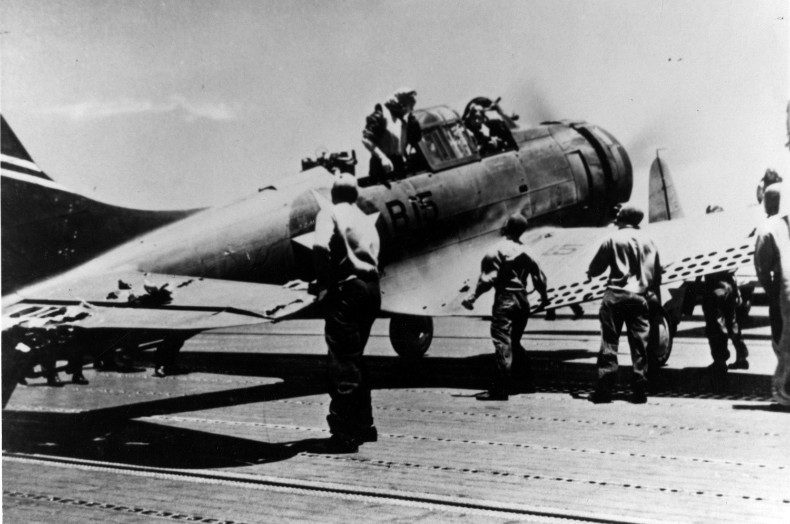
“The Douglas SBD Dauntless was a World War II American naval scout plane and dive bomber that was manufactured by Douglas Aircraft from 1940 through 1944. The SBD (“Scout Bomber Douglas”) was the United States Navy’s main carrier-borne scout plane and dive bomber from mid-1940 through mid-1944. The SBD was also flown by the United States Marine Corps, both from land air bases and aircraft carriers. The SBD is best remembered as the bomber that delivered the fatal blows to the Japanese carriers at the Battle of Midway in June 1942.
During its combat service, the SBD was an excellent naval scout plane and dive bomber. It possessed long range, good handling characteristics, maneuverability, potent bomb load, great diving characteristics, good defensive armament and ruggedness. One land-based variant of the SBD — in omitting the arrestor hook — was purpose-built for the U.S. Army Air Forces, as the A-24 Banshee.”
Credit/Source:
https://en.wikipedia.org/wiki/Douglas_SBD_Dauntless
PT-17 Stearman
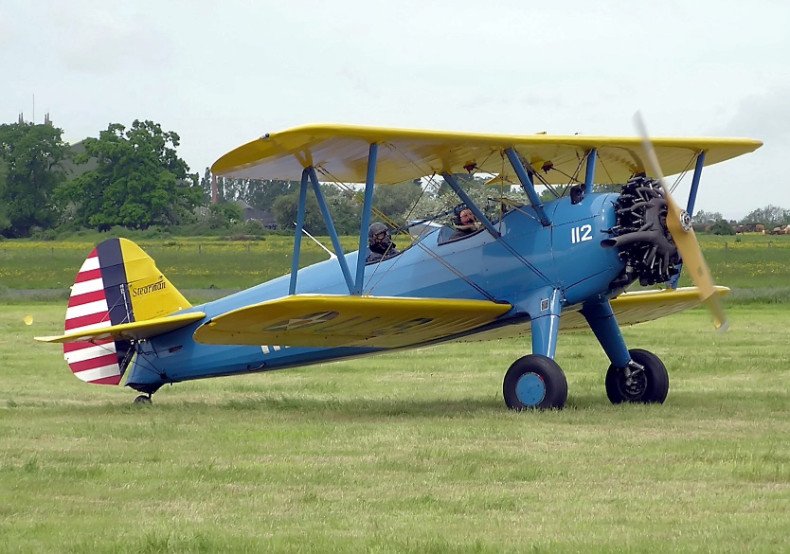
“The Stearman (Boeing) Model 75 is a biplane used as a military trainer aircraft, of which at least 10,626 were built in the United States during the 1930s and 1940s.[1] Stearman Aircraft became a subsidiary of Boeing in 1934. Widely known as the Stearman, Boeing Stearman or Kaydet, it served as a primary trainer for the United States Army Air Forces, the United States Navy (as the NS & N2S), and with the Royal Canadian Air Force as the Kaydet throughout World War II. After the conflict was over, thousands of surplus aircraft were sold on the civilian market. In the immediate postwar years they became popular as crop dusters, sports planes, and for aerobatic and wing walking use in air shows.”
Credit/Source:
https://en.wikipedia.org/wiki/Boeing-Stearman_Model_75
P-47 Thunderbolt
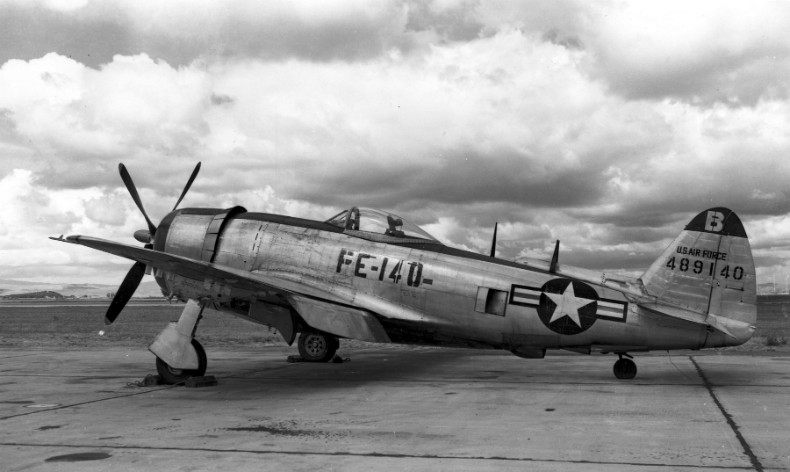
“The Republic P-47 Thunderbolt was a World War II era fighter aircraft produced by the United States between 1941–1945. Its primary armament was eight .50-caliber machine guns and in the fighter-bomber ground-attack role it could carry five-inch rockets or a bomb load of 2,500 pounds (1,103 kg), more than half the payload of the Boeing B-17 Flying Fortress bomber. When fully loaded the P-47 weighed up to eight tons (tonnes) making it one of the heaviest fighters of the war. The P-47 was designed around the powerful Pratt & Whitney R-2800 Double Wasp engine which was also used by two U.S. Navy fighters, the Grumman F6F Hellcat and the Vought F4U Corsair. The Thunderbolt was effective as a short-to-medium range escort fighter in high-altitude air-to-air combat and ground attack in both the World War II European and Pacific theaters.
The P-47 was one of the main United States Army Air Forces (USAAF) fighters of World War II, and served with Allied air forces including France, Britain, and Russia. Mexican and Brazilian squadrons fighting alongside the U.S. were equipped with the P-47.
The armored cockpit was relatively roomy and comfortable, offering good visibility. A modern-day U.S. ground-attack aircraft, the Fairchild Republic A-10 Thunderbolt II, takes its name from the P-47.”
Credit/Source:
https://en.wikipedia.org/wiki/Republic_P-47_Thunderbolt
T-41 Mescalero
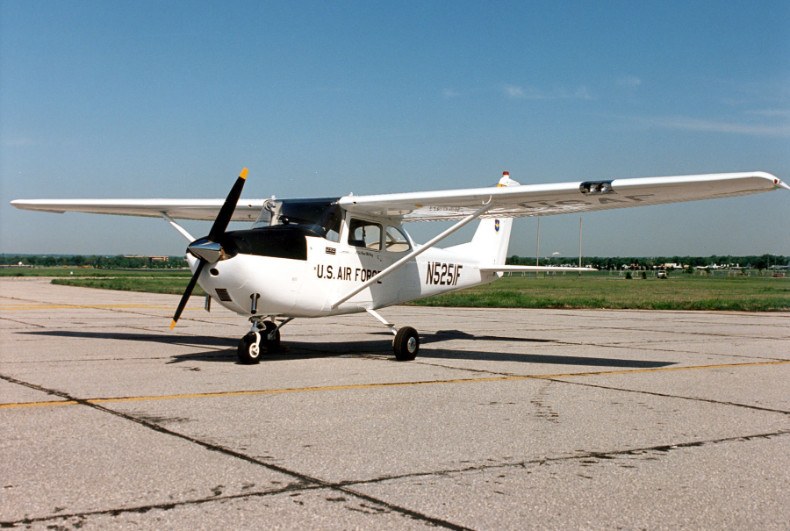
“The Cessna T-41 Mescalero is a military version of the popular Cessna 172, operated by the United States Air Force and Army as well as the armed forces of various other countries as a pilot training aircraft.”
Credit/Source:
https://en.wikipedia.org/wiki/Cessna_T-41_Mescalero
A-1D Skyraider
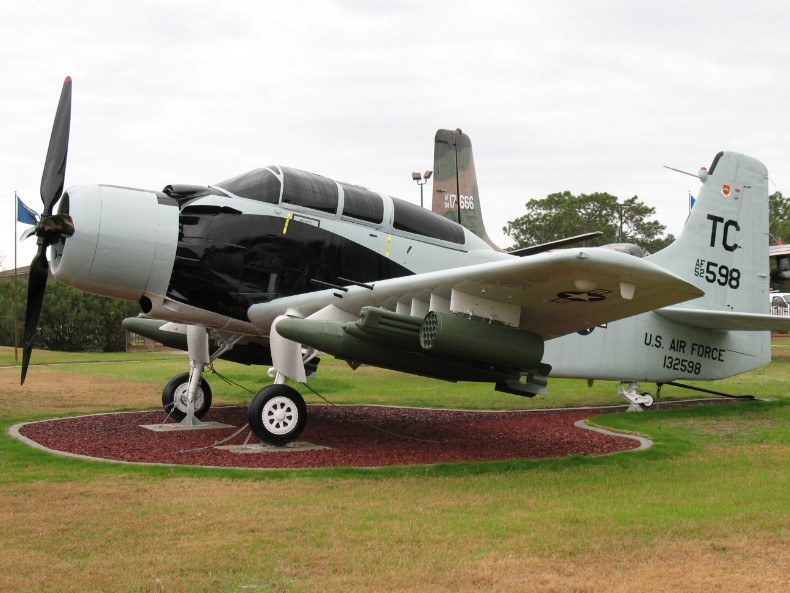
“The Douglas A-1 Skyraider (formerly AD) is an American single-seat attack aircraft that saw service between the late 1940s and early 1980s. The Skyraider had a remarkably long and successful career; it became a piston-powered, propeller-driven anachronism in the jet age, and was nicknamed “Spad”, after the French World War I fighter.
It was operated by the United States Navy (USN), the United States Marine Corps (USMC) and the United States Air Force (USAF), and also saw service with the British Royal Navy, the French Air Force, the Air Force of the Republic of Vietnam (VNAF), and others. In U.S. service, it was finally replaced by the LTV A-7 Corsair II swept wing subsonic jet in the early 1970s.”
Credit/Source:
https://en.wikipedia.org/wiki/Douglas_A-1_Skyraider
F7F Tigercat
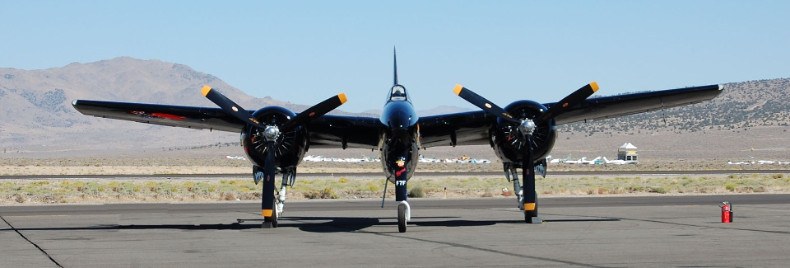
“The Grumman F7F Tigercat is a heavy fighter aircraft that served with the United States Navy (USN) and United States Marine Corps (USMC) from late in World War II until 1954. It was the first twin-engined fighter to be deployed by the USN. While the Tigercat was delivered too late to see combat in World War II, it saw action as a night fighter and attack aircraft during the Korean War.
Designed initially for service on Midway-class aircraft carriers, early production F7Fs were land-based variants. The type was too large to operate from older and smaller carriers, and only a late variant (F7F-4N) was certified for carrier service.”
Credit/Source:
https://en.wikipedia.org/wiki/Grumman_F7F_Tigercat
PT-22 Recruit
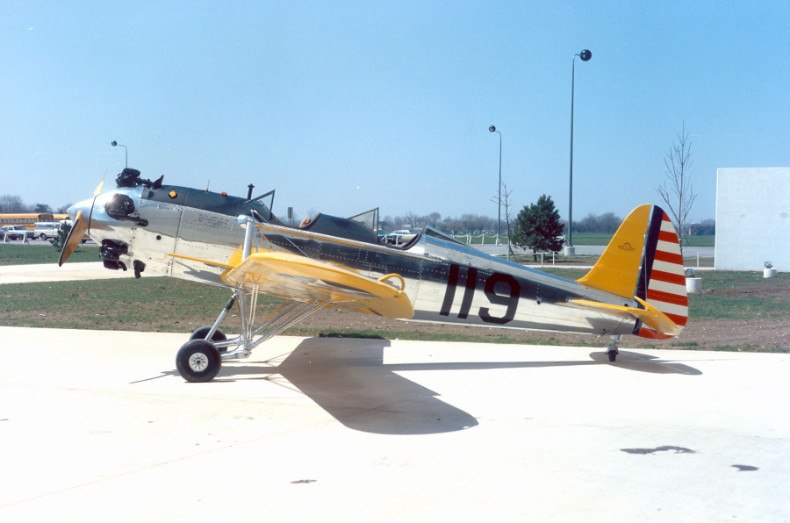
“The PT-22 was developed in 1941 from the civilian Ryan ST series. The earlier PT-20 and PT-21 were the military production versions of the Ryan ST-3 with a total of 100 built. The PT-22 was the United States Army Air Corps’ first purpose built monoplane trainer. The rapid expansion of wartime aircrew training required new trainers, and the Ryan PT-22 was ordered in large numbers. Named the “Recruit”, it entered operational service with the U.S. Orders also were placed by the Netherlands, but were never realized as the nation capitulated to Axis forces. The small order of 25 ST-3s was redirected to the United States and redesignated as the PT-22A. Another order also came from the U.S. Navy for 100 examples. The PT series was in heavy use throughout the war years with both military and civil schools, but with the end of the war, was retired from the U.S.A.A.F.”
Credit/Source:
https://en.wikipedia.org/wiki/Ryan_PT-22_Recruit
O-2 Skymaster
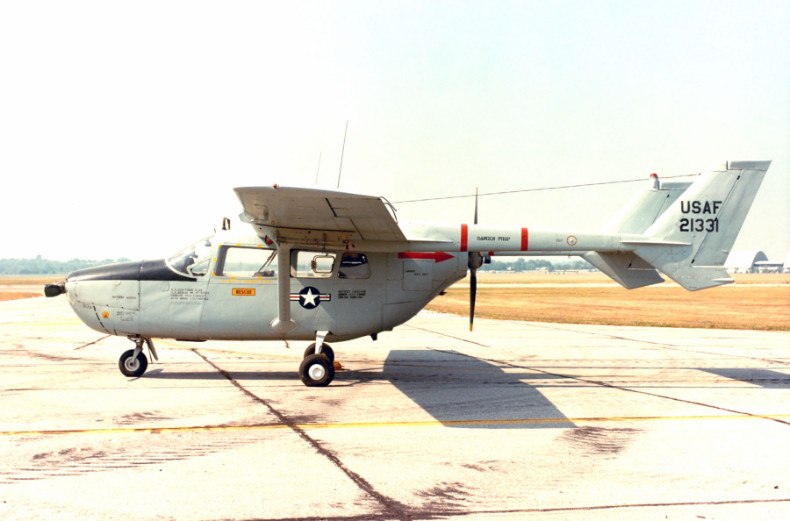
“The Cessna O-2 Skymaster (nicknamed “Oscar Deuce”) is a military version of the Cessna 337 Super Skymaster, used for forward air control (FAC) and psychological operations (PSYOPS) by the US military between 1967 and 2010.
In 1966 the United States Air Force (USAF) commissioned Cessna to build a military variant to replace the O-1 Bird Dog and the O-2 resulted.”
Credit/Source:
https://en.wikipedia.org/wiki/Cessna_O-2_Skymaster
L-19/O-1 Bird Dog
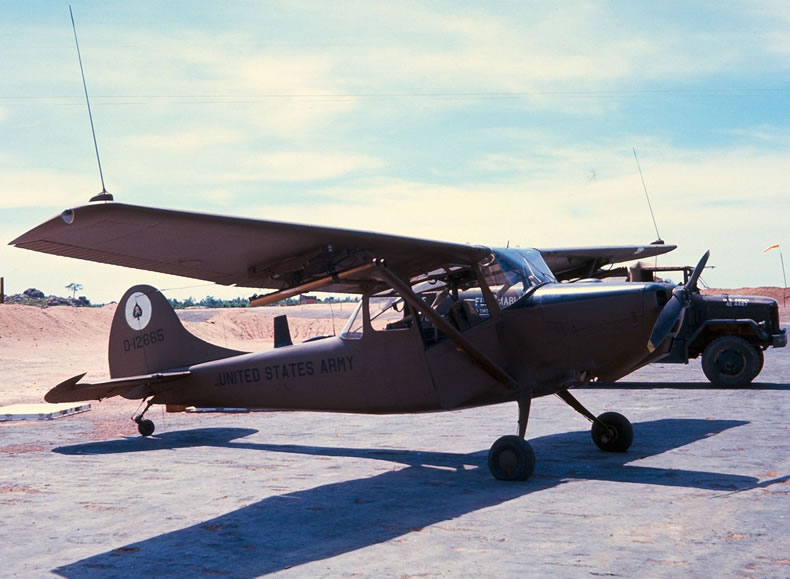
“The Cessna L-19/O-1 Bird Dog was a liaison and observation aircraft. It was the first all-metal fixed-wing aircraft ordered for and by the United States Army since the U.S. Army Air Forces separated from the Army in 1947, becoming its own branch of service, the United States Air Force. The Bird Dog had a lengthy career in the U.S. military, as well as in other countries.”
Credit/Source:
https://en.wikipedia.org/wiki/Cessna_O-1_Bird_Dog
SB2C Helldiver
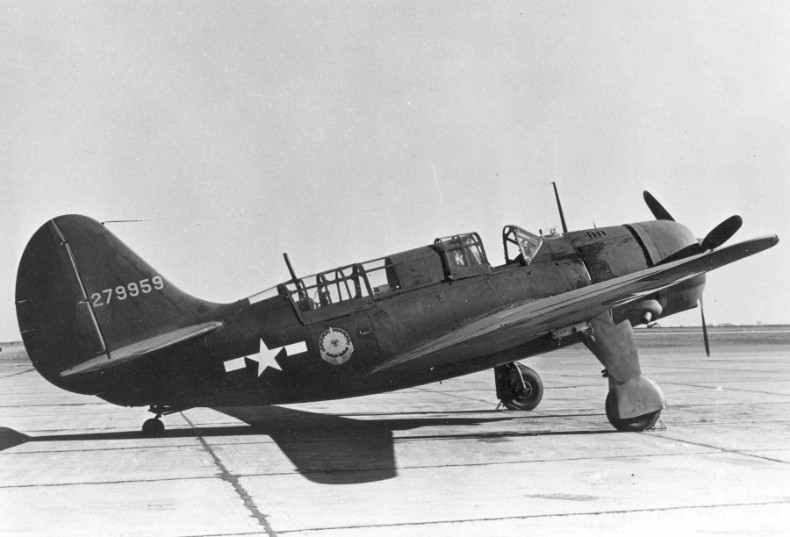
“The Curtiss SB2C Helldiver was a carrier-based dive bomber aircraft produced for the United States Navy during World War II. It replaced the Douglas SBD Dauntless in US Navy service. The SB2C was much faster than the SBD it replaced.
Crew nicknames for the aircraft included the Big-Tailed Beast (or just the derogatory Beast), Two-Cee and Son-of-a-Bitch 2nd Class (after its designation and partly because of its reputation for having difficult handling characteristics). Neither pilots nor aircraft carrier captains seemed to like it.
Delays marred its production—by the time the A-25 Shrike variant for the USAAF was deployed in late 1943, the Army Air Forces no longer had a need for a thoroughbred dive bomber. Poor handling of the aircraft was another factor that hampered its service introductions; both the British Royal Navy and the Royal Australian Air Force cancelled substantial orders.
The Truman Committee investigated Helldiver production and turned in a scathing report, which eventually led to the beginning of the end for Curtiss. Problems with the Helldiver were eventually ironed out, and in spite of its early problems, the aircraft was flown through the last two years of the Pacific War with a fine combat record.”
Credit/Source:
https://en.wikipedia.org/wiki/Curtiss_SB2C_Helldiver
P-39 Aircobra
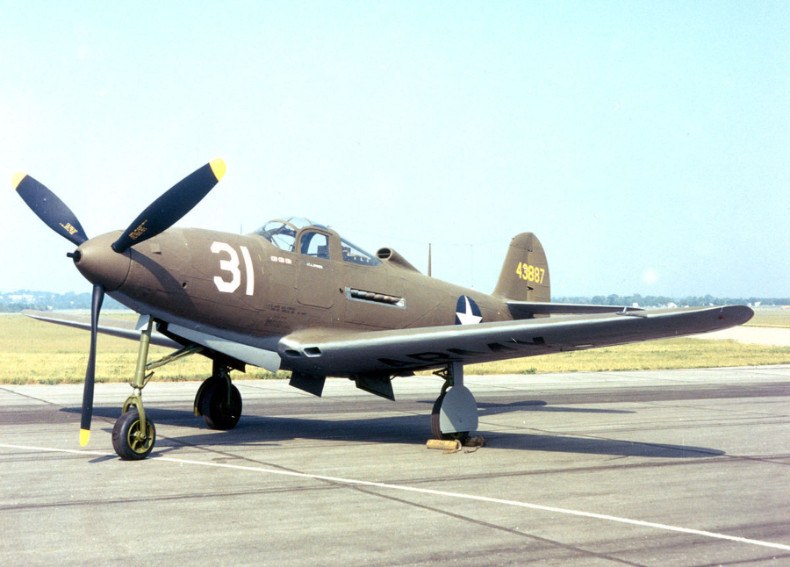
“The Bell P-39 Airacobra was one of the principal American fighter aircraft in service when the United States entered World War II. The P-39 was used with great success by the Soviet Air Force, which scored the highest number of individual kills attributed to any U.S. fighter type. Other major users of the type included the Free French, the Royal Air Force, the United States Army Air Forces, and the Italian Co-Belligerent Air Force.”
Credit/Source:
https://en.wikipedia.org/wiki/Bell_P-39_Airacobra
P-63 Kingcobra
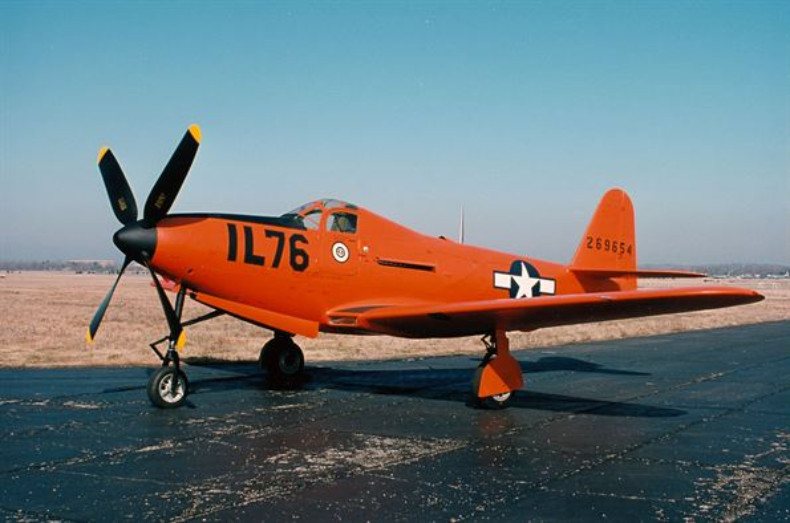
“The Bell P-63 Kingcobra is an American fighter aircraft developed by Bell Aircraft in World War II from the Bell P-39 Airacobra in an attempt to correct that aircraft’s deficiencies. Although the P-63 was not accepted for combat use by the United States Army Air Forces, it was successfully adopted by the Soviet Air Force.”
Source/Link:
https://en.wikipedia.org/wiki/Bell_P-63_Kingcobra
F4U Corsair
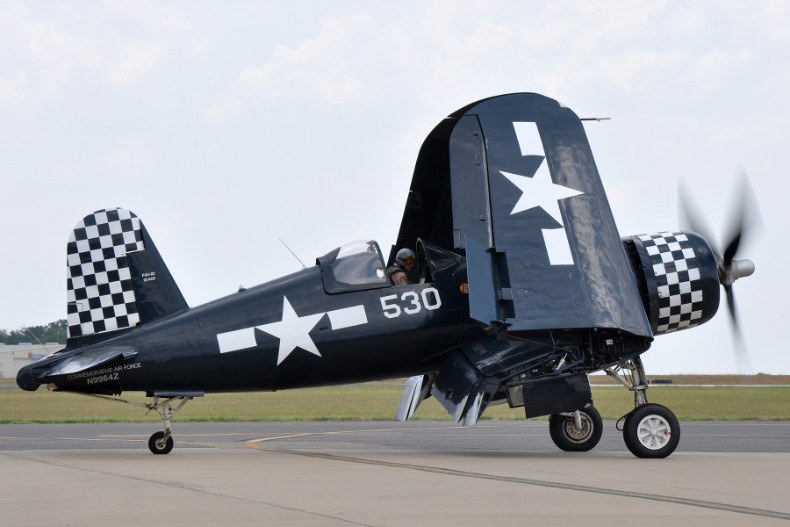
“The Vought F4U Corsair is an American fighter aircraft that saw service primarily in World War II and the Korean War. Demand for the aircraft soon overwhelmed Vought’s manufacturing capability, resulting in production by Goodyear and Brewster: Goodyear-built Corsairs were designated FG and Brewster-built aircraft F3A. From the first prototype delivery to the U.S. Navy in 1940, to final delivery in 1953 to the French, 12,571 F4U Corsairs were manufactured, in 16 separate models, in the longest production run of any piston-engined fighter in U.S. history (1942–53).
The Corsair was designed as a carrier-based aircraft but its difficult carrier landing performance rendered it unsuitable for Navy use until the carrier landing issues were overcome by the British Fleet Air Arm. The Corsair thus came to and retained prominence in its area of greatest deployment: land based use by the U.S. Marines. The role of the dominant U.S. carrier based fighter in the second part of the war was thus filled by the Grumman F6F Hellcat, powered by the same Double Wasp engine first flown on the Corsair’s first prototype in 1940. The Corsair served to a lesser degree in the U.S. Navy. As well as the U.S. and British use the Corsair was also used by the Royal New Zealand Air Force, the French Navy Aéronavale and other, smaller, air forces until the 1960s. Some Japanese pilots regarded it as the most formidable American fighter of World War II, and the U.S. Navy counted an 11:1 kill ratio with the F4U Corsair.”
Source/Link:
https://en.wikipedia.org/wiki/Vought_F4U_Corsair
P-51 Mustang – 3x!
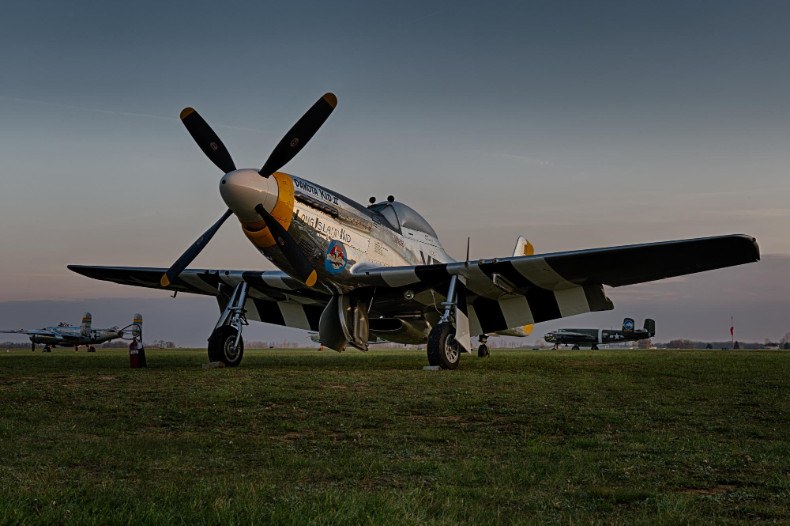
“The North American Aviation P-51 Mustang is an American long-range, single-seat fighter and fighter-bomber used during World War II, the Korean War and other conflicts. The Mustang was designed in 1940 by North American Aviation (NAA) in response to a requirement of the British Purchasing Commission for license-built Curtiss P-40 fighters. The prototype NA-73X airframe was rolled out on 9 September 1940, 102 days after the contract was signed and first flew on 26 October.
The Mustang was originally designed to use the Allison V-1710 engine, which, in its earlier variants, had limited high-altitude performance. It was first flown operationally by the Royal Air Force (RAF) as a tactical-reconnaissance aircraft and fighter-bomber (Mustang Mk I). The addition of the Rolls-Royce Merlin to the P-51B/C model transformed the Mustang’s performance at altitudes above 15,000 ft, matching or bettering that of the Luftwaffe’s fighters. The definitive version, the P-51D, was powered by the Packard V-1650-7, a license-built version of the Rolls-Royce Merlin 66 two-stage two-speed supercharged engine, and was armed with six .50 caliber (12.7 mm) M2/AN Browning machine guns.
From late 1943, P-51Bs (supplemented by P-51Ds from mid-1944) were used by the USAAF’s Eighth Air Force to escort bombers in raids over Germany, while the RAF’s 2 TAF and the USAAF’s Ninth Air Force used the Merlin-powered Mustangs as fighter-bombers, roles in which the Mustang helped ensure Allied air superiority in 1944.[10] The P-51 was also used by Allied air forces in the North African, Mediterranean and Italian theaters, and also served against the Japanese in the Pacific War. During World War II, Mustang pilots claimed 4,950 enemy aircraft shot down.
At the start of the Korean War, the Mustang was the main fighter of the United Nations until jet fighters such as the F-86 took over this role; the Mustang then became a specialized fighter-bomber. Despite the advent of jet fighters, the Mustang remained in service with some air forces until the early 1980s. After World War II and the Korean War, many Mustangs were converted for civilian use, especially air racing, and increasingly, preserved and flown as historic warbird aircraft at airshows.”
Credit/Source:
https://en.wikipedia.org/wiki/North_American_P-51_Mustang
B-25 Mitchell
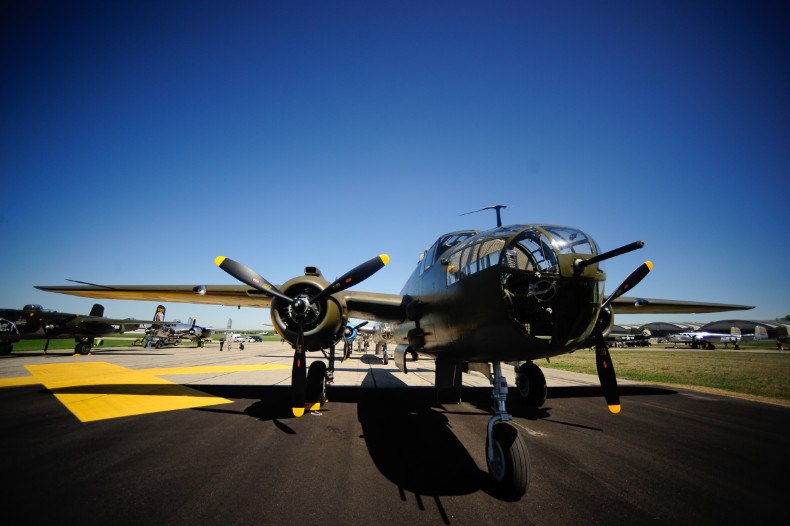
“The B-25 medium bomber was one of America’s most famous airplanes of World War II. It was the type used by Gen. Jimmy Doolittle for the Tokyo Raid on April 18, 1942.Subsequently, B-25s saw duty in every combat area being flown by the Dutch, British, Chinese, Russians and Australians in addition to U.S. forces. Although the airplane was originally intended for level bombing from medium altitudes, it was used extensively in the Pacific Theater for bombing Japanese airfields and beach emplacements from treetop level, and for strafing and skip bombing enemy shipping.Built by North American Aviation, the B-25 first flew on Aug. 19, 1940, and the U.S. Army Air Corps accepted the first five B-25s in February 1941. By the end of the war, North American Aviation had built a total of 9,816 B-25s at its California and Kansas plants.”
Source/Credit:
http://www.nationalmuseum.af.mil/Visit/MuseumExhibits/FactSheets/Display/tabid/509/Article/196310/north-american-b-25b-mitchell.aspx
P-40 Warhawk
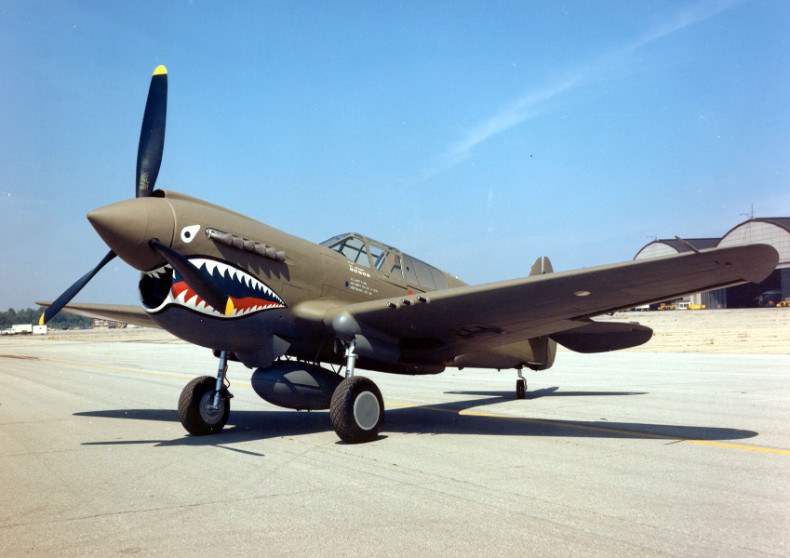
“The P-40 was the United States’ best fighter available in large numbers when World War II began. P-40s engaged Japanese aircraft at Pearl Harbor and in the Philippines in December 1941. They also served with the famed Flying Tigers in China in 1942, and in North Africa in 1943 with the 99th Fighter Squadron, the first African American U.S. fighter unit.
The solid, reliable Warhawk was used in many combat areas — the Aleutian Islands, Italy, the Middle East, the Far East, the Southwest Pacific and some were sent to Russia. Though often slower and less maneuverable than its adversaries, the P-40 earned a reputation in battle for extreme ruggedness. It served throughout the war but was eclipsed by more capable aircraft. More than 14,000 P-40s were built, and they served in the air forces of 28 nations.”
Source/Credit:
http://www.nationalmuseum.af.mil/Visit/MuseumExhibits/FactSheets/Display/tabid/509/Article/196309/curtiss-p-40e-warhawk.aspx
C-47 “That’s All Brother”
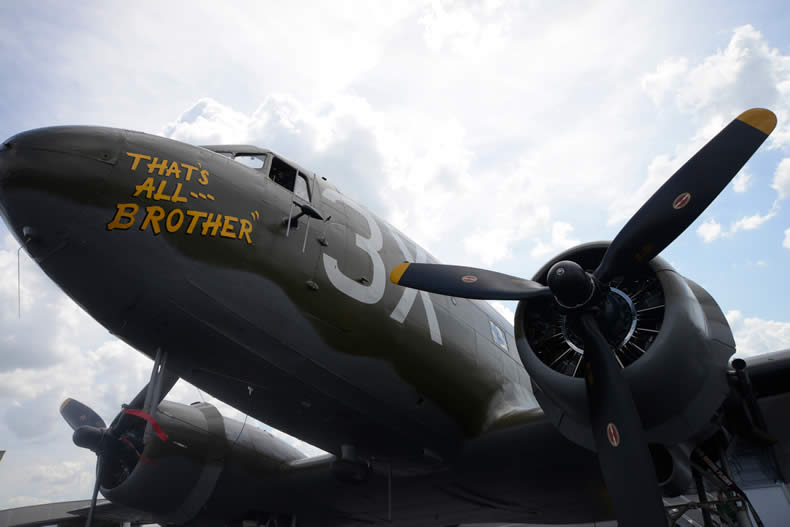
An iconic piece of history will be featured at the 2018 CAF Wings Over Houston Airshow! Come out and get up close to one of the first aircraft to carry troops into the battle of Normandy during World War II. Not only will you be able to get up close to this amazing aircraft, but you will also be able to tour inside for a small fee. Proceeds raised by That’s All, Brother at the 2018 Airshow will go towards returning the aircraft to Normandy for the 75th Anniversary of D-Day.
On June 6, 1944 . . .
“Nearly 75 years ago, on June 6, 1944, That’s All Brother carried the first of the paratroopers from the 101st and 82nd Airborne divisions. Piloted by Lt. Col John Donalson, the plane led over 800 C-47s which dropped over 13,000 paratroopers into a battle that changed the course of mankind. Our mission is to bring this great airplane back to the skies over Normandy for the commemoration of the 75th anniversary of D-Day.”
“As part of the Commemorative Air Force (CAF) Central Texas Wing, That’s All Brother is collaborating with three other CAF C-47/DC-3 airplanes to make the epic journey back over the Atlantic in 2019. We will be retracing the classic ferry path from the United States to Canada, Greenland, Iceland, Scotland, and England to join up with over 30 C-47/DC-3 airplanes in Duxford, England as part of the Daks over Normandy project. From there, we will travel to Normandy for the 75th anniversary, then to Germany to commemorate the 70th anniversary of the Berlin Airlift.”
Info & Photo Source: ThatsAllBrother.org
Please note: Aircraft ABOVE might not be the exact model, type, tail flash, or paint scheme shown. All display aircraft are subject to change without notice.
SAVE UP to 18% OFF* Airshow Tickets until this Friday, Oct 19th!
Please remember, airshow ticket prices INCREASE this Friday, October 19th, at 11:59 PM Central Time. Don’t miss your LAST chance to SAVE up to 18% OFF* 2018 Wings Over Houston Airshow tickets. This year’s airshow features the United States Navy Blue Angels!
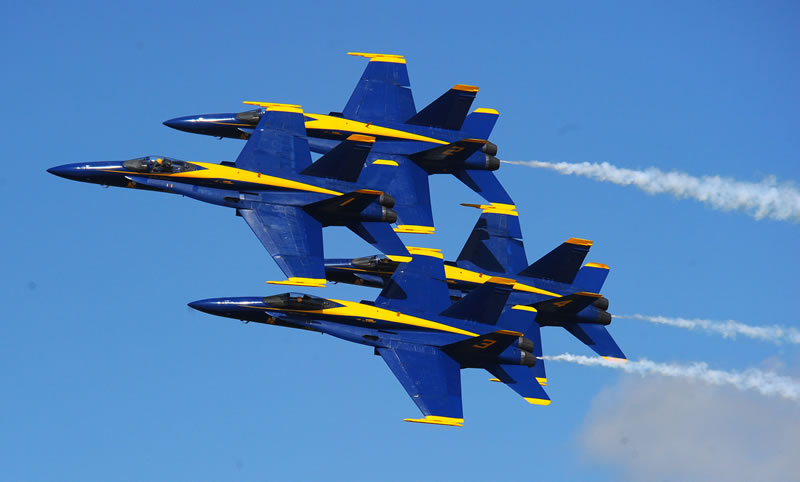 Important note: Your Insider ONLY discount is automatically applied to any tickets you select during the checkout process. The prices you see in the cart are discounted INSIDER ONLY prices. Just click below and select your tickets.
Important note: Your Insider ONLY discount is automatically applied to any tickets you select during the checkout process. The prices you see in the cart are discounted INSIDER ONLY prices. Just click below and select your tickets.
 * Service Fees may be applicable
* Service Fees may be applicable
Note: All performers and participants are subject to change without notice. If anything does change, we’ll do our best to let you know. Thank you!
Your Privacy is of paramount importance to us. Be sure to review our updated privacy policy for more details.
[/text_output][/vc_column][/vc_row]
